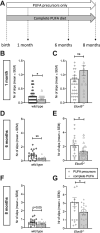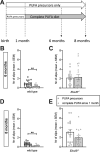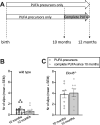Effects of the administration of Elovl5-dependent fatty acids on a spino-cerebellar ataxia 38 mouse model
- PMID: 35933444
- PMCID: PMC9357323
- DOI: 10.1186/s12993-022-00194-4
Effects of the administration of Elovl5-dependent fatty acids on a spino-cerebellar ataxia 38 mouse model
Abstract
Background: Spinocerebellar ataxia 38 (SCA38) is a rare autosomal neurological disorder characterized by ataxia and cerebellar atrophy. SCA38 is caused by mutations of ELOVL5 gene. ELOVL5 gene encodes a protein, which elongates long chain polyunsaturated fatty acids (PUFAs). Knockout mice lacking Elovl5 recapitulate SCA38 symptoms, including motor coordination impairment and disruption of cerebellar architecture. We asked whether, in Elovl5 knockout mice (Elovl5-/-), a diet with both ω3 and ω6 PUFAs downstream Elovl5 can prevent the development of SCA38 symptoms, and at which age such treatment is more effective. Elovl5-/- mice were fed either with a diet without or containing PUFAs downstream the Elovl5 enzyme, starting at different ages. Motor behavior was assessed by the balance beam test and cerebellar structure by morphometric analysis.
Results: The administration from birth of the diet containing PUFAs downstream Elovl5 led to a significant amelioration of the motor performance in the beam test of Elovl5-/- mice, with a reduction of foot slip errors at 6 months from 2.2 ± 0.3 to 1.3 ± 0.2 and at 8 months from 3.1 ± 0.5 to 1.9 ± 0.3. On the contrary, administration at 1 month of age or later had no effect on the motor impairment. The cerebellar Purkinje cell layer and the white matter area of Elovl5-/ -mice were not rescued even by the administration of diet from birth, suggesting that the improvement of motor performance in the beam test was due to a functional recovery of the cerebellar circuitry.
Conclusions: These results suggest that the dietary intervention in SCA38, whenever possible, should be started from birth or as early as possible.
Keywords: Elovl5; Motor deficits; Polyunsaturated fatty acids; SCA38; Spino-cerebellar ataxia.
© 2022. The Author(s).
Conflict of interest statement
The research was conducted in the absence of any commercial or financial relationships that could be construed as a potential conflict of interest.
Figures




Similar articles
-
Motor Deficits and Cerebellar Atrophy in Elovl5 Knock Out Mice.Front Cell Neurosci. 2017 Oct 30;11:343. doi: 10.3389/fncel.2017.00343. eCollection 2017. Front Cell Neurosci. 2017. PMID: 29163054 Free PMC article.
-
Clinical and neuroradiological features of spinocerebellar ataxia 38 (SCA38).Parkinsonism Relat Disord. 2016 Jul;28:80-6. doi: 10.1016/j.parkreldis.2016.04.030. Epub 2016 Apr 27. Parkinsonism Relat Disord. 2016. PMID: 27143115 Free PMC article.
-
Spinocerebellar ataxia 38: structure-function analysis shows ELOVL5 G230V is proteotoxic, conformationally altered and a mutational hotspot.Hum Genet. 2023 Aug;142(8):1055-1076. doi: 10.1007/s00439-023-02572-y. Epub 2023 May 18. Hum Genet. 2023. PMID: 37199746 Free PMC article.
-
Spinocerebellar Ataxia Type 38.2019 Jul 11. In: Adam MP, Feldman J, Mirzaa GM, Pagon RA, Wallace SE, Amemiya A, editors. GeneReviews® [Internet]. Seattle (WA): University of Washington, Seattle; 1993–2025. 2019 Jul 11. In: Adam MP, Feldman J, Mirzaa GM, Pagon RA, Wallace SE, Amemiya A, editors. GeneReviews® [Internet]. Seattle (WA): University of Washington, Seattle; 1993–2025. PMID: 31294938 Free Books & Documents. Review.
-
Potential Clinical Benefit of Very Long Chain Fatty Acid Supplementation in Spinocerebellar Ataxia Type 34.Cerebellum. 2024 Oct;23(5):2193-2196. doi: 10.1007/s12311-024-01705-x. Epub 2024 May 21. Cerebellum. 2024. PMID: 38771545 Review.
Cited by
-
Dietary and lifestyle interventions for the management of hereditary ataxias.Front Nutr. 2025 Apr 24;12:1548821. doi: 10.3389/fnut.2025.1548821. eCollection 2025. Front Nutr. 2025. PMID: 40342369 Free PMC article. Review.
-
Beyond Fluidity: The Role of Lipid Unsaturation in Membrane Function.Cold Spring Harb Perspect Biol. 2023 Jul 5;15(7):a041409. doi: 10.1101/cshperspect.a041409. Cold Spring Harb Perspect Biol. 2023. PMID: 37277191 Free PMC article. Review.
References
MeSH terms
Substances
Grants and funding
LinkOut - more resources
Full Text Sources
Molecular Biology Databases

